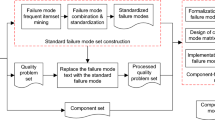Abstract
The healthcare industry depends on a large number of medical devices to perform many of its functions, so a considerable amount of effort is spent to deal with failures occurred in medical devices. This paper proposes a method that generates knowledge used to identify the causes of medical device failures and to predict the times-to-failure (i.e., a period during which a medical device operates without failure). To generate knowledge for failure cause identification, morphemes of the failure data in the existing database are analyzed and similar failures (symptoms and causes) are grouped based on the similarity of symptoms. To generate knowledge for the prediction of the times-to-failure, the Weibull distribution parameters are estimated based on a device’s previous failure dates. The experiment results show that the proposed method has 69 % accuracy in identifying the cause of failure and 83 % accuracy in predicting the times-to-failure. The proposed method enables medical device users to quickly identify the cause of failure when their devices have problems, thereby reducing the cost of failure. With the predicted time to failure, it is possible to have devices (or device parts) ready just in time for replacement. This leads to decreased inventory costs.











Similar content being viewed by others
Notes
Data published by the Ministry of Health and Welfare, South Korea.
References
Da Costa CA, Ydamin AC, Geyer CFR (2008) Toward a general software infrastructure for ubiquitous computing. IEEE Pervasive Comput 7(1):64–73
Jung HS, Baek JK, Jeong CS, Lee YW, Hong PD (2007) Unified ubiquitous middleware for U-City. Convergence information technology, 2007. International Conference, pp 2374–2379
Kwon PJ, Kim H, Kim UM (2009) A study on the web-based intelligent self-diagnosis medical system. Adv Eng Softw 40(6):402–406
Lee JI (2009) Home automation system based on ubiquitous. J Korea Acad Indus Cooper Soc 10(11):3039–3042
Watson RT, Pitt LF, Berthon P, Zinkhan GM (2002) U-commerce: expanding the universe of marketing. J Acad Mark Sci 30(4):333–347
Lee YH, Han DM, Park HK, Lee JD, Koo YW (2005) A demand analysis and market prospect on a portable internet service. Proc Korean Soc Internet Inform Conf 6(1):349–352
Kim HC, Kang JM (2008) Status and prospects of technology for ubiquitous healthcare. Commun Korean Inst Inform Sci Eng 26(1):38–45
Angeli C, Chatzinikolaou A (2004) On-line fault detection techniques for technical systems: a survery. Int J Comput Sci Appl I(1):12–30
Xiong L, Tan Q (2011) A configurable approach to toleration of soft errors via partial software protection. J Converg 2(1):31–38
Wallace DR, Kuhn DR (2001) Failure modes in medical device software: an analysis of 15 years of recall data. Int J Reliab Qual Saf Eng 8:351–372
Ryu DW (2009) A method for generating rule-based fault diagnosis knowledge on smart home environment. J Korea Acad Indus Cooper Soc 10(10):2741–2749
Lee DG, Kim JW, Lee HS (2008) A case study on determining doors maintenance intervals through running fault data analysis for metro EMU. J Korean Soc Railway 11(3):240–247
Choi JM, Yang SH, Hwang YH, Son IS, On YS, Kim YJ (2010) Failure data analysis of J79 engine transfer gearbox for aircraft maintenance planning. Trans Korean Soc Mech Eng A 34(6):781–787
Lee T, Yu F, Lin Y, Kong X, Yu Y (2011) Trusted computing dynamic attestation using a static analysis based behaviour model. J Converg 2(1):61–68
Sal DD, Casany MP, Pey JL (2010) Cooperative cache analysis for distributed search engines. Int J Inform Technol Commun Converg 1(1):41–65
Lee SJ, Kim TW, Lee KH (1999) Estimation of required time period in terms of expected residual failure data rate based on the Weibull distribution. The Fall Conference of Korea Institute of Communication Science
Baeza-Yates R, Ribeiro-Neto B (1999) Modern information retrieval. Addison-Wesley, Reading
Cavnar WB, Trenkle JM (1994) N-gram-based text categorization. In: Proceedings of SDAIR-94, pp 161–175
Cho HY, Choi SP, Choi JH (2001) A study on the development of a practical morphological analysis system based on word analysis. J Korean Soc Inf Manag 18(2):105–124
Shim KS, Yang JH (2004) High speed Korean morphological analysis based on adjacency condition check. J KISS Softw Appl 31(1):89–99
Klyuev V, Oleshchuk V (2011) Semantic retrieval: an approach to representing, searching and summarising text documents. Int J Inform Technol Commun Converg 1(2):221–234
Kim HS, Park HC (1998) Statistics for division of commerce. Hyung-Seul Publishers, Seoul
Author information
Authors and Affiliations
Corresponding author
Rights and permissions
About this article
Cite this article
Ryu, D.W., Kang, K.J., Yeo, S.S. et al. Generating knowledge for the identification of device failure causes and the prediction of the times-to-failure in u-Healthcare environments. Pers Ubiquit Comput 17, 1383–1394 (2013). https://doi.org/10.1007/s00779-012-0573-7
Received:
Accepted:
Published:
Issue Date:
DOI: https://doi.org/10.1007/s00779-012-0573-7




